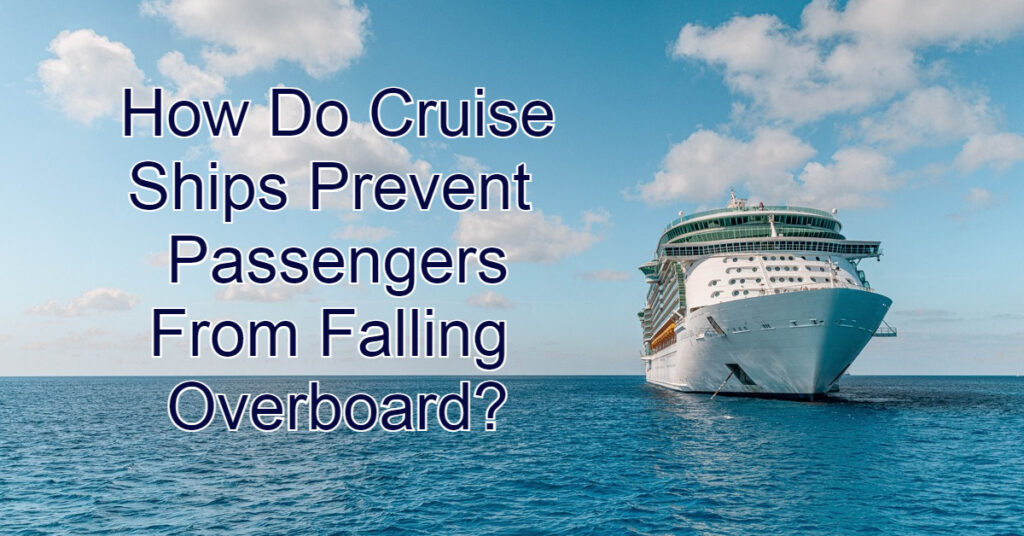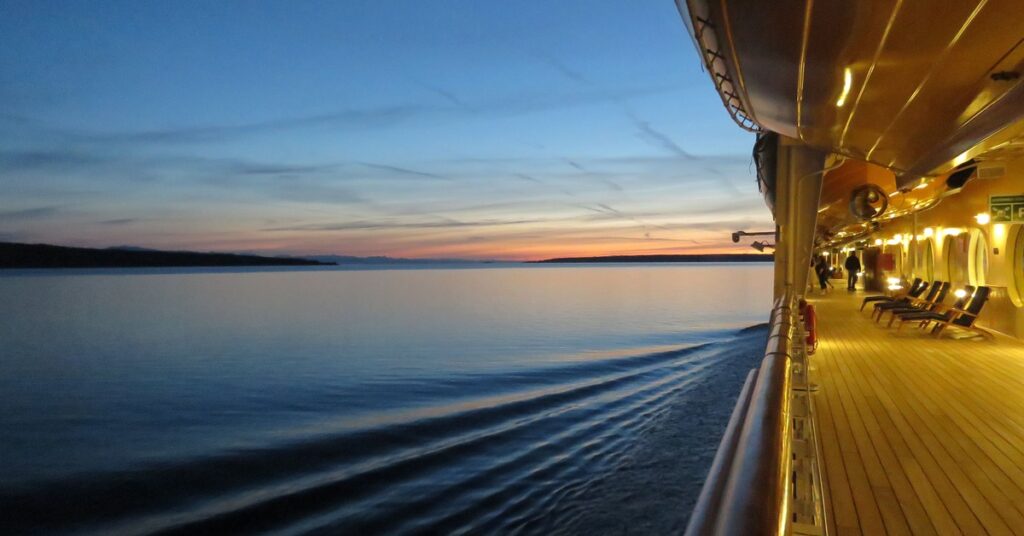Cruise ships are supposed to be places for fun and relaxation, but sometimes disaster strikes and a passenger falls overboard. This emergency happens an average of 19 times every year, and many of the passengers don’t survive.
These massive vessels carry thousands of people who are untrained for sea travel, so the crew must take every precaution. Here are the various ways that cruise ships prevent passengers from falling overboard.

Ship Design and Construction
The most important preemptive step to avoid cruise ship overboard situations takes place during the cruise ship’s design and construction process. Architects need to account for every possible location where a passenger might fall overboard. The most likely places are windows, balconies and railings.
- Windows: All cruise ship windows are made of tempered glass so nothing can break them from either side. They’re also surrounded by windbreaks to slow down wind speeds around the ship.
- Balconies: All balconies on the ship have high railings and barriers at least 42 inches tall so people can’t lean over and fall overboard.
- Railings: The railings around the balconies have gaps only a few inches wide so children can’t slip through.
Cruise ships must also remain as stable as possible while navigating rough waters so people don’t fall overboard. Every ship includes a handful of stabilizers that counteract the ocean’s rolling motion so the deck doesn’t rock back and forth. These stabilizers are attached to the side of the hull and sit below the water line.
All ships must also pass an inclining test before their completion to ensure that they’re safe for public use. The goal of this test is to determine the center of gravity and metacentric height, which are the main indicators of a ship’s stability. Inclining tests are required every five years or whenever the ship experiences a weight increase of 2% or more.
The ship’s deck is the other key design feature that prevents passengers from falling overboard. Parquet wood flooring is the material of choice for most cruise ships, providing a firm walking surface so passengers don’t slip and fall. The decks are always safe to walk on, even if they get wet from the ocean or rain.
Ship Surveillance
Cruise ships have advanced surveillance systems and tracking technologies so the crew can monitor every passenger. The most important surveillance tools are traditional CCTV security cameras that cover busy locations such as the main deck and balconies near the passengers’ bedrooms. They can’t be in each individual room, but they cover all communal areas.
The cameras also have thermal imaging for night vision. This feature is crucial because passengers are more likely to fall overboard at night for two big reasons — poorer visibility and consumption of alcoholic beverages. Plus, if someone does fall overboard at night, the crew needs thermal imaging to spot the person floating in the water.
The final key component of cruise ship surveillance is the overboard detection system. The Cruise Vessel Security and Safety Act requires all passenger vessels in the U.S. to incorporate technology that captures images or detect passengers who fall overboard.
Overboard detection systems use thermal cameras and micro radars to identify when someone or something falls overboard. While this technology used to sound the alarm for seagulls and other non-emergencies, it has since become more dependable. The Disney Cruise Line has confirmed its entire fleet has these systems.
Family and friends of cruise passengers can even follow the location of cruise ships with ship tracking apps such as CruiseMapper and Ship Mate. These apps provide an itinerary of the ship’s voyage, deck plans and real-time notifications of the ship’s progress.
Crew Training Protocols
Most cruise ships have more than 1,000 crew members to supervise and assist the passengers. They all undergo extensive emergency response and rescue training, which includes procedures such as lifeguard rescue situations and performing CPR. They must review these procedures before each voyage and practice regular drills.
Regardless of their position, all crew members must earn an International Certificate of Competence to find employment on a cruise ship. ICC courses cover all the basic seafaring skills that employees need to know. That means every crew member on the ship is qualified to address a man-overboard situation without consulting a superior.
Certain crew members are also equipped with active fall protection equipment for rescue situations. Active fall equipment includes components that require human operators such as anchorage points, body harnesses and snap hooks. Passive fall equipment includes guardrails, fences and other parts of the ship’s design.
Another key aspect of crew training on cruise ships is staying active at lookout points. There are a handful of dedicated lookout points on every cruise ship that crew members must occupy at all times. There must be a crew member supervising every passenger cabin level and every deck area, both inside and outside.
Finally, crew members are trained to have a zero-tolerance attitude toward ship violations. Passengers can get kicked off a cruise for minor infractions such as disorderly conduct, buying alcohol for minors and throwing trash overboard.
Passenger Safety Measures
There are numerous safety measures in place that reduce the likelihood of a man-overboard situation. For starters, cruise ships are full of enhanced warning signs that notify passengers about choppy waters, danger zones and other threats that might cause someone to fall overboard. Keeping people informed is the simplest way to avoid an accident.
Cruise ships also have strict access control protocols that prevent passengers from walking around certain areas. The crew’s quarters, captain’s bridge and engine room are just a few examples. These places have more safety hazards than passenger areas, so they need to stay off-limits to non-crew members.
Sometimes it’s necessary to move passengers to certain rooms if they’re highly susceptible to motion sickness or have mobility issues that increase the chances of falling overboard. Lower passenger decks are the best rooms for these at-risk passengers because they don’t feel the vessel sway as much.

The crew will also assist these passengers with navigating the ship as much as possible. Cruise ships have large corridors, automatic doors, elevators and special seating so people with disabilities can move around without restriction. These features aren’t just for passenger convenience, but for their safety as well.
Finally, all passengers must go through a muster drill after the ship makes each stop. Muster drills are simple briefings that passengers attend so they know the do’s and don’ts of sea travel, plus some emergency procedures. If a passenger fails to attend a muster drill, the crew has the authority to kick the person off the cruise.
New Technologies
Cruise ships have gotten much safer in recent years thanks to some new technologies. The most important example is electronic key cards. These simple devices allow cruise ships to track the activity of each passenger. They can see when people enter their rooms, visit the restaurant or go to the fitness center.
Balcony motion sensors play a similar role, tracking when people step outside to use the balconies connected to their cabins. This level of monitoring can help the crew identify a passenger’s most recent whereabouts, thus shortening the response time and increasing the chance of a successful rescue.
Some cruise ships also provide virtual balconies for interior cabins to enhance the guest experience and reduce traffic along the outer decks. These passengers can get the same views without the risk of falling overboard.
Collaboration With Maritime Authorities
Cruise ships frequently collaborate with maritime authorities to enforce safety protocols and help with emergency situations. The main legislative body that cruise ships work with is the International Ship and Port Facility Security Code (ISPS), which identifies procedural or design deficiencies to maintain a safe environment for passengers and crew.
The U.S. Coast Guard steps in to help ships with search and rescue missions. While it’s often the U.S., other countries can also assist with the rescue effort if the cruise ship is in international waters. Some cruise ships will bring a Coast Guard officer on board to help them debrief passengers about man-overboard scenarios.
Follow-Up Investigations
Finally, cruise ships must conduct follow-up investigations for man-overboard emergencies and make adjustments accordingly. In most cases the ship does nothing wrong and a passenger simply jumps overboard, but an investigation into the incident is still required. Further research might reveal a shortcoming with the ship’s rules or emergency protocols.
Moreover, an investigation might reveal that drugs, alcohol or foul play were involved in the passenger’s fall. No matter who is to blame, it’s important to discover the root cause of the incident so cruise ships can update their safety or security measures and prevent similar disasters in the future.
Saving Passengers From Themselves
Many of these safety protocols are about saving passengers from themselves. Most people who go on cruises aren’t accustomed to sea travel and don’t know the risks involved. Cruise ships are designed to prevent man-overboard situations at every turn, whether they’re in their cabins or on the ship’s busiest deck.
Frequently Asked Questions
How many people fall overboard on cruise ships?
An average of 19 people fall overboard on cruise ships every year according to statistics from 2009 to 2019. While that number may seem like a lot, more than 29 million people go on cruises around the world each year.
What are the keys to preventing passengers from falling overboard on cruise ships?
There are seven keys to preventing man-overboard situations — ship designs, ship surveillance, crew training, passenger safety protocols, new technology, collaboration with maritime authorities and thorough follow-up investigations.
Are all crew members trained to deal with man-overboard situations?
Yes, all crew members undergo training to deal with man-overboard situations, including people who work at the bar, restaurant, pool and other recreational facilities.
What happens when a passenger falls overboard?
When someone falls overboard, the ship’s overboard detection system will immediately sound an alarm and crew members will start the search and rescue process. They will contact the Coast Guard for assistance if they can’t immediately find the missing passenger.
Are cruise ships safer than they used to be?
Yes, cruise ships are safer now than they’ve ever been thanks to new technology, design improvements and more comprehensive training requirements for the crew.
- The Push to Reduce Cruise Ship Carbon Emissions in 2024 – July 19, 2024
- Marine Satellite Internet: How Ships Keep Connected – July 10, 2024
- What to Wear on a Boat – June 24, 2024




Leave a Reply